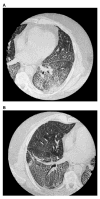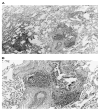Newly recognized occupational and environmental causes of chronic terminal airways and parenchymal lung disease
- PMID: 23153608
- PMCID: PMC3515663
- DOI: 10.1016/j.ccm.2012.09.002
Newly recognized occupational and environmental causes of chronic terminal airways and parenchymal lung disease
Abstract
With the introduction of new materials and changes in manufacturing practices, occupational health investigators continue to uncover associations between novel exposures and chronic forms of diffuse parenchymal lung disease and terminal airways disease. To discern exposure-disease relationships, clinicians must maintain a high index of suspicion for the potential toxicity of occupational and environmental exposures. This article details several newly recognized chronic parenchymal and terminal airways. Diseases related to exposure to indium, nylon flock, diacetyl used in the flavorings industry, nanoparticles, and the World Trade Center disaster are reviewed. Also reviewed are methods in worker surveillance and the potential use of biomarkers in the evaluation of exposure-disease relationships.
Copyright © 2012 Elsevier Inc. All rights reserved.
Figures






Similar articles
-
Potential for diffuse parenchymal lung disease after exposures at World Trade Center Disaster site.Mt Sinai J Med. 2008 Mar-Apr;75(2):101-7. doi: 10.1002/msj.20025. Mt Sinai J Med. 2008. PMID: 18500711 Review.
-
Upper and lower respiratory diseases after occupational and environmental disasters.Mt Sinai J Med. 2008 Mar-Apr;75(2):89-100. doi: 10.1002/msj.20028. Mt Sinai J Med. 2008. PMID: 18500710
-
Fixed obstructive lung disease among workers in the flavor-manufacturing industry--California, 2004-2007.MMWR Morb Mortal Wkly Rep. 2007 Apr 27;56(16):389-93. MMWR Morb Mortal Wkly Rep. 2007. PMID: 17464280
-
Hazardous occupational exposure and lung disease among nylon flock workers.Am J Ind Med. 1999 Sep;Suppl 1:145-6. doi: 10.1002/(sici)1097-0274(199909)36:1+<145::aid-ajim51>3.0.co;2-f. Am J Ind Med. 1999. PMID: 10519816 No abstract available.
-
Occupational lower airway disease in relation to World Trade Center inhalation exposure.Curr Opin Allergy Clin Immunol. 2011 Apr;11(2):97-102. doi: 10.1097/ACI.0b013e3283449063. Curr Opin Allergy Clin Immunol. 2011. PMID: 21325944 Free PMC article. Review.
Cited by
-
[Occupational interstitial lung diseases].Radiologie (Heidelb). 2024 Aug;64(8):636-642. doi: 10.1007/s00117-024-01342-9. Epub 2024 Jul 16. Radiologie (Heidelb). 2024. PMID: 39012478 Free PMC article. Review. German.
-
Misdiagnosis in occupational and environmental medicine: a scoping review.J Occup Med Toxicol. 2021 Aug 24;16(1):33. doi: 10.1186/s12995-021-00325-z. J Occup Med Toxicol. 2021. PMID: 34429147 Free PMC article.
-
Adverse reactions of Amiodarone.J Geriatr Cardiol. 2019 Jul;16(7):552-566. doi: 10.11909/j.issn.1671-5411.2019.07.004. J Geriatr Cardiol. 2019. PMID: 31447894 Free PMC article. Review.
-
Imaging diagnosis of classical and new pneumoconiosis: predominant reticular HRCT pattern.Insights Imaging. 2021 Mar 10;12(1):33. doi: 10.1186/s13244-021-00966-y. Insights Imaging. 2021. PMID: 33689008 Free PMC article. Review.
-
Subclinical interstitial lung damage in workers exposed to indium compounds.Ann Occup Environ Med. 2013 Oct 21;25(1):24. doi: 10.1186/2052-4374-25-24. Ann Occup Environ Med. 2013. PMID: 24472147 Free PMC article.
References
-
- Tyler PM. Minor Metals, in Minerals. US Bureau of Mines; 1937. pp. 759–786.
-
- Minami H. Kinzoku-Shigen Report. 2010. Trend of demand, supply and price of indium and gallium; pp. 81–93.
-
- Homma T, et al. Interstitial pneumonia developed in a worker dealing with particles containing indium-tin oxide. J Occup Health. 2003;45(3):137–9. - PubMed
Publication types
MeSH terms
Substances
Grants and funding
LinkOut - more resources
Full Text Sources
Medical

